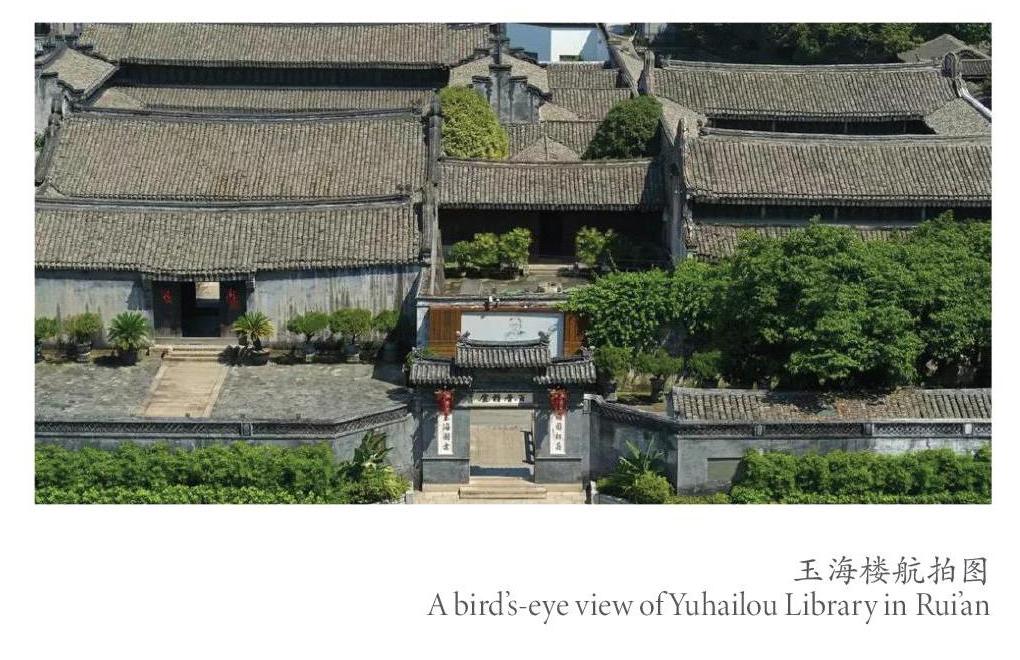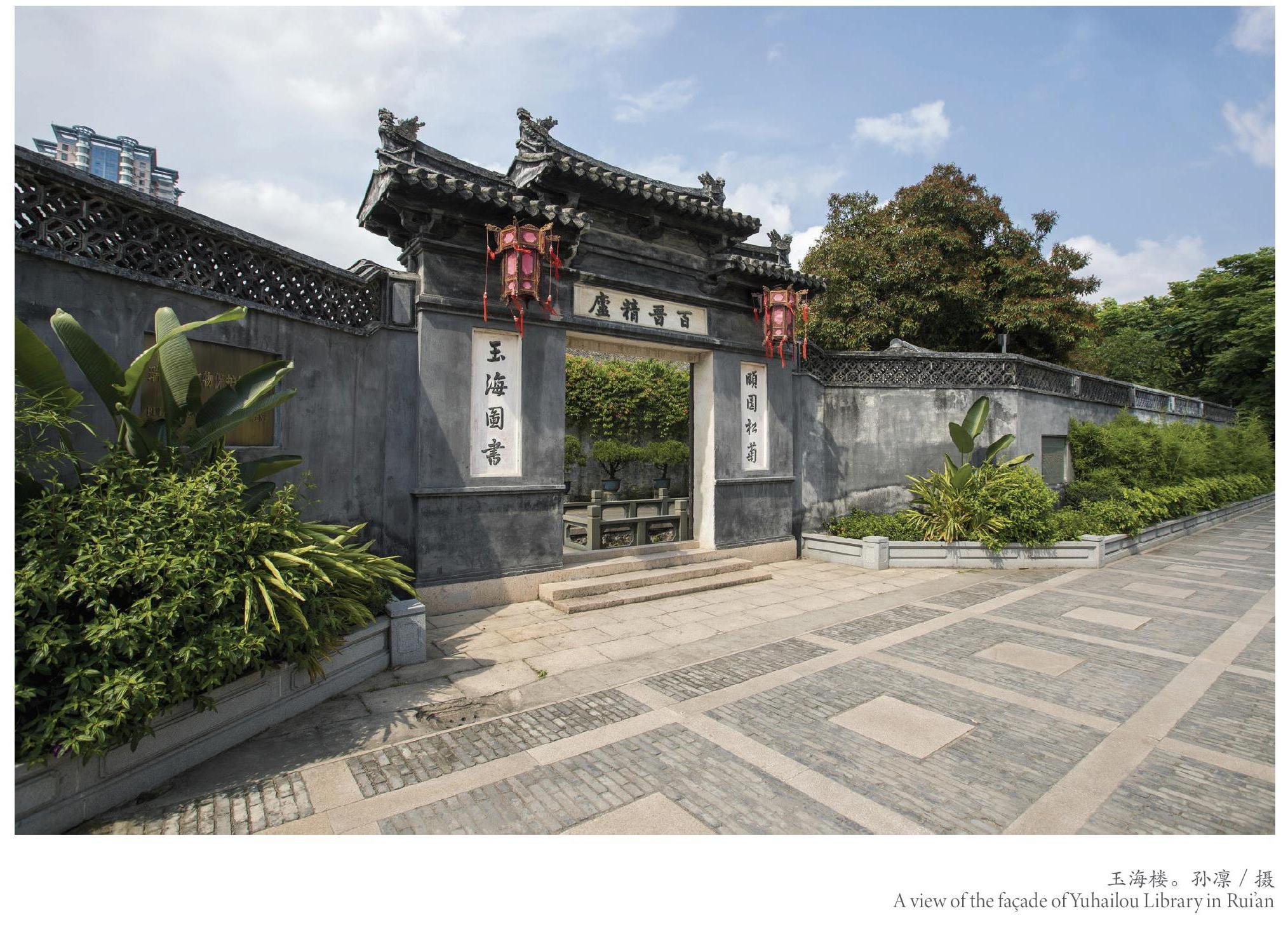玉海楼:玉成桃李 海涌波澜
2021-03-26



玉海楼,坐落在浙江瑞安市区道院前街,是我国江南的著名藏书楼之一,为清光绪十五年(1889年)太仆寺卿孙衣言所创建,孙氏因慕宋王应麟博极群书,遂以其巨著《玉海》名斯楼。衣言子诒让为清末朴学大师,在此潜心著述垂三十年。玉海楼现为全国重点文物保护单位。
玉海楼原有图书八九万卷,均系孙氏父子大力搜求所得,其中多乡邦文献、珍籍善本。现藏书三万多册,其中珍善本四千册,以富名家批校本、乡邦文献和珍善本闻名于世。
新中国成立以来,玉海楼经多次整修,已渐复旧观。自从文物馆驻内办公以后,栽松莳花,美化了环境,并征集到大批古籍、字画和文物,经常举办各种展览,供人观赏。
孙氏父子建玉海
玉海楼这个具有浙南特色的建筑群由玉海藏书楼、孙诒让故居和百晋陶斋组成,分别坐落在南北相向的三条纵轴线上,总占地面积约8000平方米。玉海楼建筑古朴,树木苍翠,绿荫蔽空,庭院四季花木芬芳醉人。
沿着青青的池塘往玉海楼行进,首先映入眼帘的是嵌在庄重的台门上的清朝礼部侍郎李文田书写的“玉海楼书藏”石额,左右石联“玉成桃李,海涌波澜”为郭沫若所题。
穿过台门,进入天井,迎面矗立的就是玉海书楼。玉海楼的两层建筑,上间大厅前,两根粗大的立柱托着宽敞的前廊。精巧古朴的门窗均是木质方格式,近年来虽经过修缮,但仍保持着清代风韵。一层和顶层的出檐深远,檐口均饰有漂亮的瓦当,飞椽斗拱,特显江南的独具风格。
楼前正方匾额“玉海楼”由清朝的工部侍郎潘祖荫题写。走进楼内,这里清新整洁,据工作人员介绍:里面的3万余册藏书井然有序地保存在这里,防潮防霉设施都很周到。
在这里,可以全面地了解孙诒让先生的生平事迹。孙诒让出生于1848年,同治六年举人,官刑部主事,有“晚清经学后殿”、“朴学大师”之称。与俞樾、黄以周合称“清末三先生”。其父孙衣言,清道光三十年进士,官至太仆寺卿,有“晚清特立之儒”之称。
孙诒让故居的台门取名为“百晋精庐”,两旁的对联,“颐园松菊,玉海图书”,是孙诒让的手迹。孙诒让故居具有鲜明的建筑特色,平面布局由门屋、客厅、正楼三进构成,并用天井分开,排列在同一纵轴线上,左右对称,四柱成间,继承了传统的规制。
百晋陶斋前面有个花园,叫“颐园”。园内种植四季花木,古树葱翠,是少有的古朴清幽之处。园中凿荷花池种植白莲,常年盛开不衰。原来的台门上有孙衣言的手迹,写着“方石额”三个字。旁边是孙衣言所写的对联“务求知古如君举,尤喜能文似水心”,是从孙衣言的善祠塾移置到此的。
客厅是当年孙衣言、孙诒让接待朝廷命官和尊贵宾客的地方,当时两边立着“迥避”“肃静”旗牌。因为客厅的抬梁结构,往往雕梁画栋,因此也叫花厅,但这里的花厅古朴大方,这也显示了孙氏是一清平官家。
客厅的中堂上悬挂着的这块蓝地金色的大匾额,外框金色云纹,格外醒目,上面写有“兄弟重游泮水,光绪十九年浙江学政陈彝立”。这块匾额讲述的是孙诒让的父亲孙衣言和叔叔孙锵鸣相继考取进士后又过了60年再重访京都、参加进士相会的盛事。
玉海楼的建筑格局是浙南地区丰富多彩的乡土建筑的典范,既承载了地方文化的内涵,又体现了瑞安文化的精华。据说玉海楼的建筑风格很有研究价值,与温州其他民居相比,更显出它的内敛和独特,是绝版的“孤本”。
永嘉学派的文化坐标
孙诒让以《周礼正义》《墨子间诂》《契文举例》三部代表作,贯穿其治学一生,玉海楼也就成为他治学、研究和发扬永嘉学派的中心和标志。他的许多著作都是在这里完成的,如《墨子间诂》《周礼正义》等。玉海楼也成为孙诒让晚年藏书、读书、交游、研学的场所,自1888年其父孙衣言为他建楼至他1908年离世,他的活动多以玉海楼为轴心。这20年间,是晚清东西学冲突与融合最为剧烈的时期,各种思潮风起云涌。其间还发生了甲午战争、百日维新运动、义和团运动等重大事件。孙诒让密切关注事态发展,积极投身兴儒救国,在寻求富国强民道路的实践过程中,将永嘉学派的经世之学传承发展,以达到“振世救敝”和“富强之原,在于兴学”的改良目的。
孙诒让虽然对国学研究很深,但他却不是个守旧的老古董,对西方先进的学说以及社会的新思潮同样也很留意。在光绪初年,孙诒让就买进了2600多册关于新学的书籍,宣统元年他还到上海几家书店去选购新书,去过的书店有文明书局、商务印书馆、科学书局等,他在那里选购了不少新的出版物,同时玉海楼也开始订购报纸和杂志,以此来了解新思潮和新观念。
光绪二十三年,孙诒让认识了章太炎,自此之后两人成为了好友。章太炎在上海办国学保存会,同时办有《国粹学报》和《古学汇刊》,通过学刊宣扬反清复明思想,从而推动中国人反抗外族压迫的思潮。而孙诒让也写了两篇文章发在这些刊物上,以此来表示自己支持朋友所进行的排满活动。其实,孙家的开放思想从孙衣言就已有之,他虽然是给儿子建起了玉海楼,但他并不反对其他人来此看书,孙衣言明确地说:“我子孙中如有得天隽敏而加以好学,能读终一书,而知其可好,则可以尽读他书。能尽读他书,则其惟我楼所藏,虽深宁所未见皆可以遍览而悉通也。复取古人读书之法,及就今日藏书之意,具为条约,揭之堂壁,乡里后生,有读书之才,读书之志,而能无违我约,皆可以就我庐,读我书,天下之宝,我固不欲为一家之储也。”这等开明之士看来在在古代并不乏其人,只是少有文献記录下来,使得人们对私家藏书楼有着许多有失偏颇的认定。
玉海楼是一座具有特殊意义的私家藏书楼。它如同一个文化坐标,将19世纪的温州文化推到一个前所未有的高度,而以孙衣言、孙锵鸣、孙诒让为代表的文化人物堪称当时温州文化的领军人物。他们上接王开祖、林石、周行己、许景衡、陈傅良、叶适等开创的永嘉学派,后启晚清东瓯务实创新的事功学说。特别是孙诒让,其后半生以弘扬传统学术为己任,将经世致用广布于世,并于国家变革之际身体力行、革故鼎新。
孫诒让还是研究甲骨文开山第一人,当年郭沫若书写中堂的刻石:“甲骨文之学创始于孙仲容,继之者为王观堂,饮水思源,二君殊可纪念。”这里的孙仲容就是孙诒让先生。
孙诒让的研究是从看到《铁云藏龟》开始的,《铁云藏龟》的出版引起了国内许多学者对甲骨文的关注,这些人中间就有孙诒让。
1903年,《铁云藏龟》影印出版不久,孙诒让就获得此书,爱不释手,用他自己的话来说,“不意衰年睹兹奇迹,爱玩不已,辄穷两月之力校读之”。第二年,孙诒让就写出了自己的研究成果,那就是《契文举例》。这部书的出版让他成为中国第一部研究甲骨文著作的作者。实际上《契文举例》只用了两个月的时间,据传在此两个月期间,孙诒让把自己关在楼上的书房里,足不出门,从早到晚一直伏案撰著。面对《铁云藏龟》中印刷并不清晰的甲骨拓片,他凭借自己对彝器和古文字学的渊博知识,对卜文进行考释,完成了五万字的《契文举例》。全书考释了约334个卜文,其中正确的约有185个。书稿撰著完成后,照原稿抄写了至少五份,分别寄给了罗振玉、刘鹗、端方等人,但一直没有出版。1908年孙诒让去世后,《契文举例》的一份手稿在上海被王国维发现,王国维称赞此书,“筚路椎轮,不得不推此也”。1917年,罗振玉不惜花费数百金,将其出版发行,此时,离孙诒让去世已九个年头了。
在考释甲骨文字的领域里,孙诒让无愧为“甲骨之先”,筚路蓝缕的开山之创是不可否认的事实与成就。
而今依旧芬芳醉人
孙诒让去世后,其家道日渐衰落,玉海楼和故居也作为家产分给他的五个儿子,藏书的第三代传人孙孟晋,从北京法政专门学校毕业后,曾任职北京财政部盐务署等处。后因孙诒让1927年归葬永嘉慈湖(今属瓯海区),孙孟晋带着当时仅8个月大的儿子孙宝麟回到瑞安。
在玉海楼中,孙孟晋恪守家规,着手整理所藏珍贵历史文献。他分别于1931年和1935年对祖辈藏书进行厘查:编有《玉海楼丛书细目》5册,其中著录丛书131种,6800余册;《瑞安孙氏玉海楼藏温州乡贤遗书目》,其中著录图书462部,其中内有明代刻本34种,抄本210种,稿本10多种。
后来,孙氏家族中有人提议将藏书卖了,孙孟晋坚决不同意。为了保护祖辈积攒下的宝贵遗产,孙孟晋在十多万册藏书中,遴选出部分珍贵书籍,保存在藤箱里携带在身边。
孙孟晋的儿子孙宝麟回忆说 :“父亲将妻儿留在温州城,而自己则带着藏书辗转丽水龙泉青田等地逃难。有一次逃难到丽水,父亲放图书的地方有两个防空洞,日本人空袭时,另一个防空洞被炸弹炸毁,幸亏书在另一个防空洞里,那次真的很危险。在逃难期间,父亲几乎是心力交瘁,于是就打算给这些书找一个稳妥的地方。
1947年,孙孟晋毅然择其中之精华465部2990册(多数为善本)、《永嘉丛书》版片2460片及文物103件,存浙江大学文学院,录有《浙江大学文学院收藏瑞安孙氏玉海楼寄存图书、文物商目》一册,全归当时的杭州大学图书馆特藏。1951年,又将玉海楼部分藏书“四部”及“丛书”2.2万册捐赠温州图书馆,其中明版书及各家批校本近2000种。1947年和1972年,先后又将随身携带至杭州所藏的先人遗译及自著手稿7种37册,分别赠送温州图书馆和北京图书馆。
另有3600册书籍,成为瑞安公共图书馆创建之时的基本藏书。玉海楼现有藏书珍贵,如《万历温州府志》《康熙瑞安县志》元巾箱本《尹文子》等皆为世之孤本;明正德林长繁本陈傅良《止斋集》、孙诒让批校明万历刻本《淮南鸿烈解》等皆为世所罕见的珍善本,殊可宝贵。先时管理严格,订有《藏书规约》十六条。
新中国成立后,当地政府重视文物保管,征集流散在外的图书以及文物、字画,庋藏楼上,楼下辟为文物陈列室。
近些年,国家和省市政府投入数百万元对玉海楼进行了七次保护维修,使玉海楼得到了更好的保护。玉海楼已开辟孙诒让纪念馆、民俗文物陈列和举办各类展览。而今,河畔古树苍翠,绿荫蔽空,庭院四季花木芬芳醉人,吸引着海内外专家、学者和各界人士纷至沓来。
Yuhailou Library in Ruian
Yuhailou Library, located at Ruian in southeastern Zhejiang, is one of the famous ancient private libraries in Jiangnan or the south of the Yangtze River Delta. It was founded in 1889 by Sun Yiyan (1815-1894), a native of Ruian and government official for decades. He retired to Ruian and built this library to house the books he had collected. The library was meant for himself and for his son Sun Yirang (1848-1908).
The collection by the father and son amounted to about 90,000 books, including many regional literature, and rare and fine editions of ancient books. After Sun Yirang passed away, a large part of the rare and fine editions of ancient books went to the library of Hangzhou University. At present, Yuhailou has a collection of 30,000 books including 4,000 rare and fine editions of ancient books. The private library is famed for books personally annotated and edited by Sun Yiyan and Sun Yirang, regional literature, and rare and fine editions.
Today, whats known as Yuhailou is an 8,000-square-meter compound comprising Yuhailou Library, the former residence of Sun Yirang, and Bai Jin Tao Zhai, which is an independent five-row structure flanked between the library and the residence. Bai Jin Tao Zhai was originally designed as a living section for guests and visitors. Later it was used as a space for the storage and display of several hundreds of ancient bricks of the Six Dynasties (317-589). Today, it showcases ancient bricks, tombstones, roof tiles, collected by Ruian Ancient Objects Museum since its inception in 1956.
The compound is in ancient architectural style, with trees and flowers and a pond. The ancient buildings feature some inscriptions handwritten by high-ranking government officials of the Qing Dynasty and Guo Moruo, a famed scholar of the 20th-century China. The architecture presents a unique style in Wenzhou, a port city in the southeast of the province where there are many ancient houses. In the eye of modern architects, the style of Yuhailou is modest and unique and therefore can be compared to an only existing copy of a book. Professor Luo Zhewen (1924-2012), a prominent scholar of ancient architecture, considered Yuhailou as a national jewel.
Since the founding of the Peoples Republic of China, Yuhailou has been well protected and has attracted hundreds of heavyweight scholars and experts to visit the ancient library. On the list of the domestic and international visitors are Guo Muoruo, Hu Qiaomu, Qi Yanming, Tian Jiaying, and Xu Jialu, and Xi Jinping.
Sun Yirang is now considered a landmark scholar of Yongjia School. As a master of ancient Confucian classics and philology, he spent about 20 years doing textual research and writing books at the library. The last 20 years in his life saw fierce interaction and confliction of the western and eastern cultures and ideologies as well as historical events such as the Sino-Japanese War from 1894 to 1895, the 100-Day Reform in 1898, and the Boxers Uprising in 1900. From the books in Yuhailou, one can assume that Sun Yirang was by no means a scholar who buried himself in ancient books. He bought over 2,600 books concerning new knowledge introduced from the west in the 1870s, years before Yuhailou was built. In 1908, three years before the Qing Dynasty disintegrated; he traveled to Shanghai and bought books from bookstores that had nothing to do with ancient Chinese classics. He concerned himself with international and domestic news and trends by reading magazines and newspapers at home.
In 1897, he made friends with Zhang Taiyan (1869-1936), a prominent scholar of ancient classics and revolutionary. Zhang Taiyan ran two magazines concerning ancient classics. Some articles were politically against the Qing. Sun published two articles in the magazines indicating his support of Zhangs political stand.
His father Sun Yiyan was an open-minded scholar. Even though the library was essentially built for his son Sun Yirang, he opened it to young scholars in the region. He said publicly, “those who have aptitude, who want to read our books, and abide by the rules of the library, can visit the library and read books here.” A list of sixteen dos and donts for readers and for the library administration was established with the inception of Yuhailou. The rules are still operative today.
Yuhailou was a cultural landmark of Wenzhou in the 19th century. The Sun family produced prominent figures of the regional culture of Wenzhou. They carried on the torch of Yongjia School started by a group of local scholars and opened up new thought in the last decades of the Qing Dynasty. The new thought focused on knowledge for changing China.
Scholastically, Sun Yirang was the first person who studied the characters on inscriptions on bones or tortoise shells of the Shang Dynasty (c. 1600-1046 BC). After reading a book titled Tie Yun Cang Gui published in 1903 by Liu E (1857--1909), a novelist and scholar, Sun fell in love with the book, which was the first collection of characters on animal bones and tortoise shells in China. The amazing discovery of the ancient inscriptions on bones and shells is a long story of the late Qing Dynasty and opened up a new discipline in the studies of philology. Sun spent two months studying the book at home; he shut himself up at Yuhailou writing a book expounding his study results of the ancient characters. The book deciphered 334 characters from the book by Liu E. Studies by other scholars later concluded that 185 of the 334 characters were correctly identified. After Sun Yirang finished the book, he made five copies and sent them respectively to Luo Zhenyu, Liu E, Duan Fang and other people. It was not published until 1917 when Luo Zhenyu raised funds and got it printed.
In the wake of Sun Yirangs demise in 1908, the library and the residence were distributed as assets to his five sons. Sun Mengjin was the third-generation curator of the library. In 1931 and 1935, he twice cataloged the collection of Yuhailou and published two books. Both were catalogs. One catalog has five volumes, listing 6,800 books in 131 series. The second book cataloged all the 462 titles by local authors of Wenzhou, including 34 titles published in the Ming Dynasty, 210 scribed copies, and more than 10 manuscripts.
During World War Two, Sun Mengjin did all he could to protect the books from Japanese invaders. He left his wife and sons in Wenzhou and moved all the books to safe houses in southern part of the province. The collection was fortunate enough to escape bombings and came out of the war intact. Understanding he wasnt able to keep the collection in his own hands, he decided to donate a large of the collection to institutions.
In 1947, Sun Mengjin donated 2,990 ancient books in 465 titles, 2,460 printing blocks of Yongjia Series, and 103 cultural objects to the Literature College of Zhejiang University. All the donations were cataloged and published in a book. Then the donations went to the Library of Hangzhou University. In 1951, Sun donated 22,000 books to Wenzhou Library, including 2,000 books published in the Ming Dynasty and annotated by his ancestors. In 1947 and 1972, he donated some books to Wenzhou Library and Beijing Library. He also donated 3,600 books to Ruian Library.
In the current collection of Yuhailou, there are some only copies of books in the world. Since the founding of the Peoples Republic, Yuhailou has been well preserved. Its collection has expanded. In recent years, the library has been refurbished seven times thanks to the funds allotted from the central, provincial and local governments.
